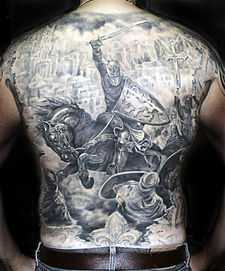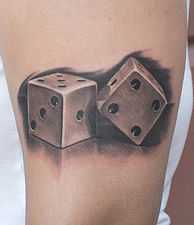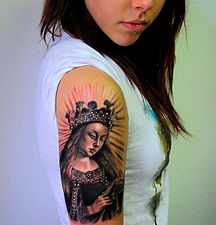Black-and-gray

Black-and-gray (also black-and-grey, black and grey/gray) is a style of tattooing that uses only black ink in varying shades and typically uses a single needle. This tattooing style is thought to have originated from prisons in the 1970s and 1980s and was later popularized in tattoo parlors.
Origin
Black-and-gray is sometimes referred to as "jailhouse"[1] or "joint style"[2] and is thought to have originated in prisons where inmates had limited access to different materials; they resorted to using guitar strings for needles[3] and used cigarette ashes or pen ink to produce tattoos.[2][4][5] Inmates would construct makeshift tattoo machines that were powered using the small motors available in tape players.[2] Prisons generally prohibit inmates from tattooing, so these were likely to be done in secret.[4] During the late 1970s and early 1980s, jailhouse then became popularized in tattoo parlors outside of prison and was renamed "black and gray".[2][6] Black-and-gray is also thought to have originated from the Chicano[7] or cholo culture in Los Angeles.[3]
Technique
Typically, black-and-gray tattoo work is produced by diluting the black ink with distilled water in varying proportions to create a "wash" that results in lighter shades.[8][9] Gray shades can also be produced by mixing small amounts of black ink with white ink, which produces a thicker but brighter result and requires a slower application.[9] Shading is typically an important component for these types of tattoos as they will fade over a period of years without strong black tones, which provide contrast and allows the tattoo to stand out.[10][11] Subtle kinds of shading in black-and-gray are considered to require a high level of skill and illustrates professionalism in the industry.[5]
Common usage
Black-and-gray techniques are often employed for a variety of tattoos. Japanese irezumi, such as the rising koi, are traditionally done using black-and-gray,[12] although colored irezumi sometimes use black-and-gray backgrounds in a manner similar to sumi-e brushwork.[13] Classic Chicano tattoos — which include a broad range of imagery such as icons in Catholicism or the Mexican flag and partially originated from prison life — are also normally done in black-and-gray.[14] Photo-realistic portraits are also commonly done in black-and-gray,[15] and typically resist deterioration better than color portraits.[16]
In some color tattoos, artists can use black-and-gray initially to provide a foundation for the subsequent shading using colors. The colored ink can be added directly above the black-and-gray portions of the tattoo.[17]
Examples
References
- ↑ Wilkinson, Beth (1999). Coping with the dangers of tattooing, body piercing, and branding. Center City, MN: Hazelden. p. 66. ISBN 1568382464.
- ↑ 2.0 2.1 2.2 2.3 Miller, Jean-Chris (1997). he Body Art Book: A Complete, Illustrated Guide to Tattoos, Piercings, and Other Body Modifications (Berkley trade pbk. ed. ed.). New York: Berkley Books. pp. 52–53. ISBN 042515985X.
- ↑ 3.0 3.1 Hemingson, Vince (2010). Alphabets and scripts tattoo design directory : the essential reference for body art. New York, N.Y.: Chartwell Books. p. 28. ISBN 0785825789.
- ↑ 4.0 4.1 Levy, Janey (2009). Tattoos in modern society (1st ed. ed.). New York: Rosen Pub. p. 39. ISBN 1404218297.
- ↑ 5.0 5.1 Gerber, Larry (2012). Getting inked : what to expect when you get a tattoo (1st ed. ed.). New York: Rosen Pub. p. 23. ISBN 1448846161.
- ↑ Kahn, Eve M. (31 January 2013). "Tattoos’ Impressions in Print and in Film". New York Times (The New York Times Company). Retrieved 19 September 2014.
- ↑ Frucci, Angela (11 January 2005). "Los Angeles is becoming the capital of tattoo artists". The Tuscaloosa News. NY Times News Service. Retrieved 20 September 2014.
- ↑ DeMello, Margo (2014). Inked: Tattoos and Body Art around the World. Santa Barbara, CA: ABC-CLIO. p. 731. ISBN 1610690761.
- ↑ 9.0 9.1 Reardon, John (2008). The complete idiot's guide to getting a tattoo. Indianapolis, IN: Alpha Books. p. 79. ISBN 1592577253.
- ↑ Reardon 2008, pp. 170–171.
- ↑ Buchanan, Fip (2014). Art of tattoo design : creating masterful tattoo art from start to finish. (1st ed.). S.l.: F&W Media Inc. p. 26. ISBN 1440328870.
- ↑ Buchanan 2014, p. 48.
- ↑ Green, Terisa (2012). The Tattoo Encyclopedia. New York: Simon and Schuster. ISBN 1471108619.
- ↑ DeMello 2014, pp. 105–106.
- ↑ Gerber 2012, p. 23.
- ↑ Buchanan 2014, p. 60.
- ↑ Jordan, C.R. (2009). Basic fundamentals of modern tattoo. Phoenix, Ariz.: Tattoo Books Online. p. 151. ISBN 0615281478. Retrieved 21 September 2014.



